Safety, Health and Welfare at Work (General Application) Regulations 2007
Schedule 9
Safety and Health Signs at Work
Part A — General requirements
1.Types of signs
1.1. Permanent signs
1.1.1. Permanent signboards shall be used for signs relating to prohibitions, warnings and mandatory requirements and the location and identification of emergency escape routes and first-aid facilities.
Signboards or a safety colour (or both) shall be used to mark permanently the location and identification of fire-fighting equipment.
1.1.2. Signboards on containers and pipes shall be placed as laid down in Part C of this Schedule.
1.1.3. Places where there is a risk of colliding with obstacles or of falling shall be permanently marked with a safety colour or with signboards (or both).
1.1.4. Traffic routes shall be permanently marked with a safety colour.
1.2. Occasional signs
1.2.1. Illuminated signs, acoustic signals or verbal communication (or both) shall be used where the occasion requires, taking into account the possibilities for interchanging and combining signs set out in Paragraph 2, to signal danger, to call persons to take a specific course of action and for the emergency evacuation of persons.
1.2.2. Hand signals or verbal communication (or both) shall be used where the occasion requires, to guide persons carrying out hazardous or dangerous manoeuvres.
2.Interchanging and combining signs
2.1. Any one of the following may be used if equally effective—
- a safety colour or a signboard to mark places where there is an obstacle or a drop,
- illuminated signs, acoustic signals or verbal communication,
- hand signals or verbal communication.
2.2. Some types of signs may be used together—
- illuminated signs and acoustic signals,
- illuminated signs and verbal communication,
- hand signals and verbal communication.
3. The instructions in the table below apply to all signs incorporating a safety colour—
|
|
Colour |
Meaning or Purpose |
Instructions and Information |
|
|
|
Red |
Prohibition sign |
Dangerous behaviour |
|
|
|
Danger alarm |
Stop, shutdown, emergency cut-out devices Evacuate |
|
|
|
|
Fire-fighting equipment |
Identification and location |
|
|
|
|
Yellow or Amber |
Warning sign |
Be careful, take precautions Examine |
|
|
|
Blue |
Mandatory sign |
Specific behaviour or action Wear personal protective equipment |
|
|
|
Green |
Emergency escape, first aid sign |
Doors, exits, routes, equipment, facilities |
|
|
|
No danger |
Return to normal |
|
4.The effectiveness of a sign shall not be adversely affected by:
4.1. the presence of another emission source of the same type which interferes with visibility or audibility; therefore, in particular—
4.1.1. the placing of too many signs too close together shall be avoided,
4.1.2. two illuminated signs which are likely to be confused shall not to be used at the same time,
4.1.3. an illuminated sign shall not be used in the proximity of another similar illuminated source,
4.1.4. two acoustic signals shall not be used at the same time,
4.1.5. an acoustic signal shall not be used if there is too much ambient noise.
4.2. poor design, insufficient number, incorrect positioning, poor state of repair or incorrect functioning of the signs or signalling devices.
5.Depending on requirements, signs and signalling devices shall be cleaned, maintained, checked repaired, and if necessary replaced on a regular basis to ensure that they retain their intrinsic or functional qualities (or both).
6. The number and positioning of signs or signalling devices to be installed will depend on the extent of the hazards or dangers or on the zone to be covered.
7. Signs requiring some form of power shall be provided with a guaranteed emergency supply in the event of a power cut, unless the hazard has thereby been eliminated.
8. The triggering of an illuminated sign or acoustic signal (or both) indicates when the required action should start and the sign or signal shall be activated for as long as the action requires.
Illuminated signs and acoustic signals shall be reactivated immediately after use.
9. Illuminated signs and acoustic signals shall be checked to ensure that they function correctly and that they are effective before they are put into service and subsequently at sufficiently frequent intervals.
10. If the hearing or the sight of the persons concerned is impaired, including impairment caused by the wearing of personal protective equipment, measures shall be taken to supplement or replace the signs concerned.
11. Areas, rooms or enclosures used for storage of significant quantities of F105[hazardous] substances or F105[mixtures] shall be indicated by a suitable warning sign taken from paragraph 3.2 of Part B, or marked as provided in paragraph 1 of Part C of this Schedule, unless the labelling of the individual packages or containers is adequate for this purpose.
F106[11A. For the purposes of paragraph 11, if there is no equivalent warning sign in paragraph 3.2 of Part B to warn about hazardous chemical substances or mixtures, the relevant hazard pictogram, as set out in Annex V to Regulation (EC) No. 1272/2008 of the European Parliament and of the Council, must be used.]
Annotations
Amendments:
F105
Substituted (18.02.2016) by Safety, Health and Welfare at Work (General Application) (Amendment) (No. 2) Regulations 2016 (S.I. No. 70 of 2016), reg. 7(a)(i), (ii).
F106
Inserted (18.02.2016) by Safety, Health and Welfare at Work (General Application) (Amendment) (No. 2) Regulations 2016 (S.I. No. 70 of 2016), reg. 7(a)(iii).
Part B — Signboards
1. Intrinsic features
1.1. The shape and colours are set out in paragraph 3, in accordance with their specific object (signboards indicating a prohibition, a warning, a mandatory action, an escape route, an emergency or fire-fighting equipment).
1.2. Pictograms shall be as simple as possible and shall contain only essential details.
1.3. The pictograms used may be slightly different from or more detailed than those shown in paragraph 3, provided that they convey the same meaning and that no difference or adaptation obscures the meaning.
1.4. Signboards shall be made of shock and weather-resistant material suitable for the surrounding environment.
1.5. The dimensions and colorimetric and photometric features of signboards shall be such that they can be easily seen and understood.
2. Conditions of use
2.1. Signboards shall be installed at a suitable height and in a position appropriate to the line of sight, taking account of any obstacles, either at the access point to an area in the case of a general hazard, or in the immediate vicinity of a specific hazard or object, and in a well-lit and easily accessible and visible location.
Without prejudice to the provisions of Part 2, Chapter 1, phosphorescent colours, reflective materials or artificial lighting shall be used where the level of natural light is poor.
2.2. The signboard shall be removed when the situation to which it refers ceases to exist.
3. Signboards to be used
3.1.Prohibitory signs—
Intrinsic features:
Round shape;
Black pictogram on white background, red edging and diagonal line (the red part to take up at least 35% of the area of the sign);
The script underneath each of the following pictograms is included here to show the meaning of the sign but is not to be included in the signboard.
That script or any other relevant script may be shown on a supplementary signboard.
Signs to be used
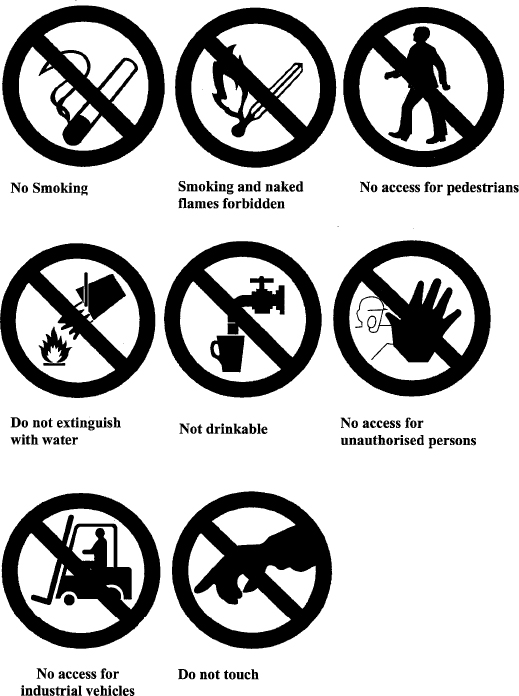
3.2. Warning signs—
Intrinsic features:
Triangular shape;
Black pictogram on a yellow background with black edging (the yellow part to take up at least 50% of the area of the sign);
The script underneath each of the following pictograms is included here to show the meaning of the sign but is not to be included in the signboard.
That script or any other relevant script may be shown on a supplementary signboard.
Signs to be used
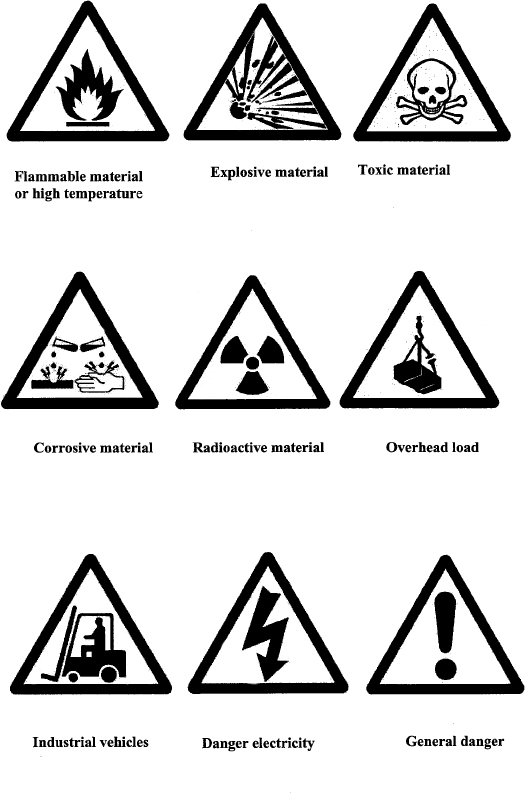
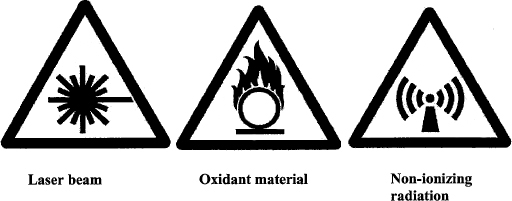
Note—“Flammable material or high temperature” sign in the absence of a specific sign for high temperature
F107[Note: The warning sign “General danger” shall not be used to warn about hazardous chemical substances or mixtures, except for cases when the warning sign is used in accordance with the second subparagraph of paragraph 5 of Part C to this Schedule to indicate the stores of hazardous substances or mixtures.]
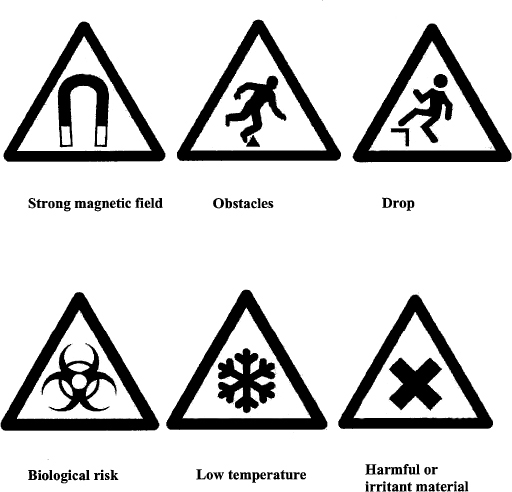
F108[…]
F108[…]
3.3. Mandatory signs
Intrinsic features:
Round shape;
White pictogram on a blue background (the blue part to take up at least 50% of the area of the sign);
The script underneath each of the following pictograms is included here to show the meaning of the sign but is not to be included in the signboard.
That script or any other relevant script may be shown on a supplementary signboard.
Signs to be used
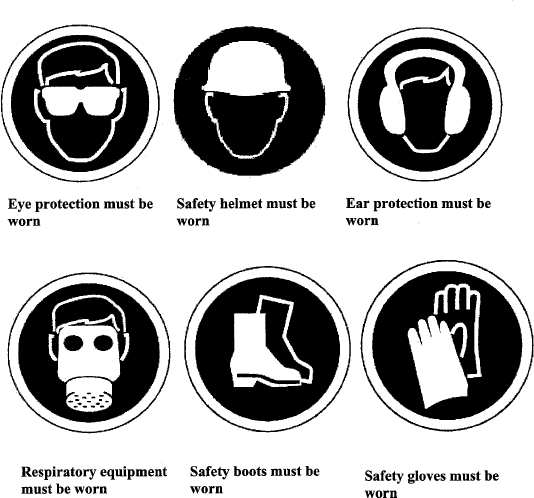
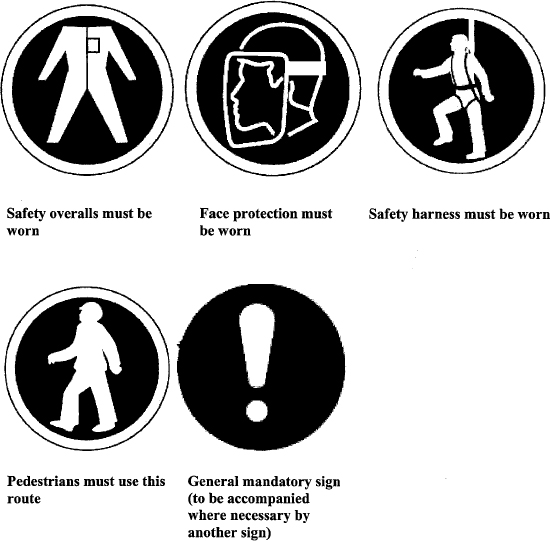
3.4. Emergency escape or first-aid signs
Intrinsic features:
Rectangular or square shape;
White pictogram on a green background (the green part to take up at least 50% of the area of the sign.);
The script underneath each of the following pictograms is included here to show the meaning of the sign but is not to be included in the signboard.
That script or any other relevant script may be shown on a supplementary signboard.
Signs to be used
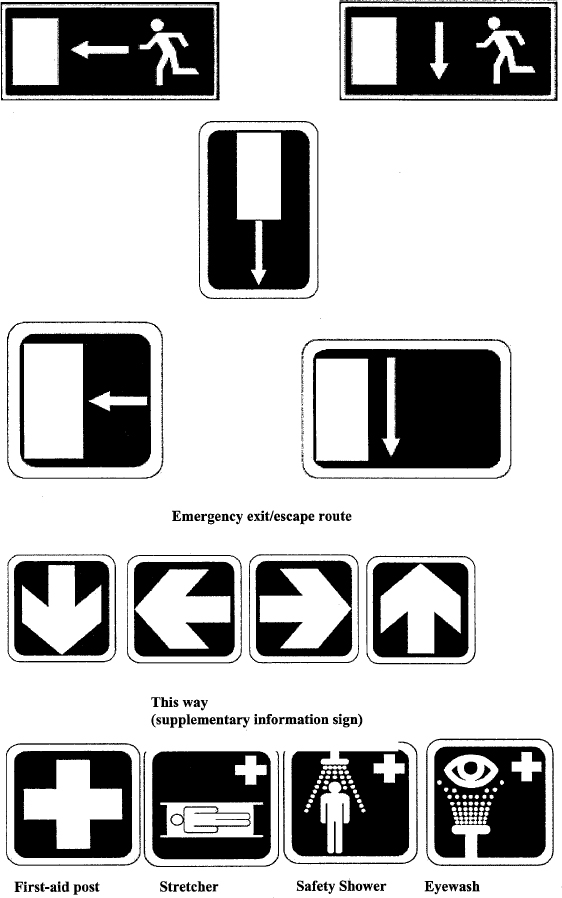
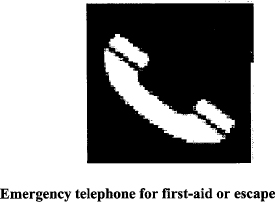
3.5. Fire-fighting signs
Intrinsic features:
Rectangular or square shape;
White pictogram on a red background (the red part to take up at least 50% of the area of the sign);
The script underneath each of the following pictograms is included here to show the meaning of the sign but is not to be included in the signboard.
That script or any other relevant script may be shown on a supplementary signboard.
Signs to be used
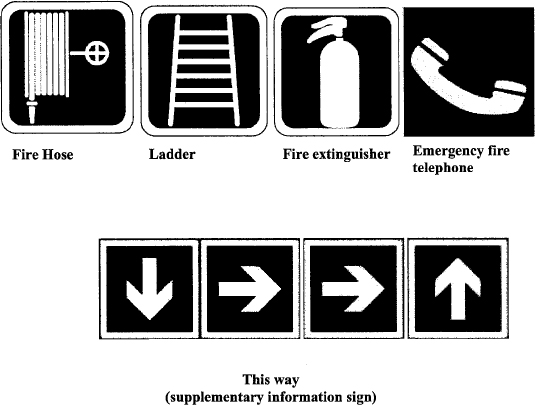
Annotations
Amendments:
F107
Inserted (18.02.2016) by Safety, Health and Welfare at Work (General Application) (Amendment) (No. 2) Regulations 2016 (S.I. No. 70 of 2016), reg. 7(b)(iii).
F108
Sign for Harmful or irritant material deleted (greyed out in image) and Note on this sign deleted (18.02.2016) by Safety, Health and Welfare at Work (General Application) (Amendment) (No. 2) Regulations 2016 (S.I. No. 70 of 2016), reg. 7(b)(i), (ii).
Part C — Signs on containers and pipes
F109[1. Containers used at work for chemical substances or mixtures classified as hazardous according to the criteria for any physical or health hazard class in accordance with Regulation (EC) No. 1272/2008, and containers used for the storage of such hazardous substances or mixtures, together with the visible pipes containing or transporting such hazardous substances and mixtures, shall be labelled with the relevant hazard pictograms in accordance with that Regulation.
This paragraph does not apply to containers used at work for brief periods nor to containers whose contents change frequently, provided that alternative adequate measures are taken, in particular for information or training (or both of them) which guarantee the same level of protection.
The labels referred to in this paragraph may be—
(a) replaced by warning signs as provided for in Part B of Schedule 9, using the same pictograms or symbols, and where there is no equivalent warning sign in paragraph 3.2 of Part B of this Schedule, the relevant hazard pictogram set out in Annex V of Regulation (EC) No. 1272/2008 shall be used,
(b) supplemented by additional information, including the name or formula (or both of them) of the hazardous substance or mixture and the details of the hazard, and
(c) used for the transporting of containers at the place of work, supplemented or replaced by signs that are applicable throughout the European Union for the transport of hazardous substances or mixtures.]
2. Signs shall be mounted as follows—
(a) on visible sides, and
(b) in unpliable, self-adhesive or painted form.
3. Where appropriate, the signs referred to in paragraph 1 of this Part shall have the intrinsic features defined in paragraph 1.4. of Part B and shall fulfil the conditions of use for signboards laid down in paragraph 2 of Part B.
4. Without prejudice to paragraphs 1, 2 and 3, the labels used on pipes shall be positioned visibly in the vicinity of the most dangerous points, such as valves and joints, and at reasonable intervals.
5. Areas, rooms or enclosures used for the storage of significant quantities of F109[hazardous] substances or F109[mixtures] shall be indicated by a suitable warning sign taken from paragraph 3.2 of Part B, or marked as provided in paragraph 1 of this Part, unless the labelling of the individual packages or containers is adequate for this purpose, taking into account paragraph 1.5 of Part B, with regard to dimensions.
Stores of a number of F109[hazardous] substances or F109[mixtures] may be indicated by the warning sign for general danger.
The signs or labels referred to above must be positioned, as appropriate, near the storage area or on the door leading into the storage room.
Annotations
Amendments:
F109
Substituted (18.02.2016) by Safety, Health and Welfare at Work (General Application) (Amendment) (No. 2) Regulations 2016 (S.I. No. 70 of 2016), reg. 7(c), (d).
Part D — Identification and location of fire-fighting equipment used exclusively for fire-fighting purposes
1. Fire-fighting equipment shall be identified by using a specific colour for the equipment and placing a location signboard, or by using a specific colour or both for the places where such equipment is kept, or their access points.
2. For the purposes of paragraph 1 the specific colour shall be red.
The red area shall be sufficiently large to allow the equipment to be identified easily.
3. The signboards provided for in paragraph 3.5 of Part B shall be used to mark the locations of this equipment.
Part E — Signs used for obstacles and dangerous locations and for marking traffic routes
1. Signs for obstacles and dangerous locations
1.1 Places where there is a risk of colliding with obstacles, of falling or of objects falling shall be marked with alternating yellow and black, or red and white stripes in built up zones in the place of work to which employees have access during their work.
1.2. The dimensions of the markings shall be commensurate with the scale of the obstacle or dangerous location in question.
1.3. The yellow and black or red and white stripes shall be at an angle of approximately 45° and of more or less equal size.
1.4. Example:

2. Marking of traffic routes
2.1. Where the use and equipment of rooms so requires for the protection of persons, traffic routes for vehicles shall be clearly identified by continuous stripes in a clearly visible colour, preferably white or yellow, taking into account the colour of the ground.
2.2. The stripes shall be located so as to indicate the necessary safe distance between the vehicles and any object which may be nearby, and between pedestrians and vehicles.
2.3. Permanent traffic routes in built-up areas outdoors shall, as far as is practicable, be similarly marked, unless they are provided with suitable barriers or pavements.
Part F — Illuminated signs
1. Intrinsic features
1.1.The light emitted by a sign shall produce a luminous contrast which is appropriate to its environment, in accordance with the intended conditions of use of the sign, but without producing glare or an excessive amount of light or poor visibility as a result of insufficient light.
1.2. The luminous area emitting a sign may be of a single colour or contain a pictogram on a specified background.
1.3. The single colour shall correspond to the table of colours and their meanings set out in paragraph 3 of Part A.
1.4. When the sign contains a pictogram, it shall comply with all the relevant requirements of Part B.
2. Specific rules governing use
2.1. If a device can emit both continuous and intermittent signs, the intermittent sign shall be used to indicate a higher level of danger or a more urgent need for the requested or required intervention or action than is indicated by the continuous sign.
The duration of each flash and the frequency of the flashes of an intermittent illuminated sign shall be such as to ensure the proper perception of the message, and avoid any confusion either between different illuminated signs or with a continuous illuminated sign.
2.2. If a flashing sign is used instead of or together with an acoustic signal, identical codes shall be used.
2.3. Devices for emitting flashing signs in the event of grave danger shall be under special surveillance or be fitted with an auxiliary lamp.
Part G — Acoustic signs
1. Intrinsic features
1.1. Acoustic signals shall:
(a) have a sound level which is considerably higher than the level of ambient noise, so that it is audible without being excessive or painful, and
(b) be easily recognisable, particularly in terms of pulse length and the interval between pulses or groups of pulses, and be clearly distinct from any other acoustic signal and ambient noises.
1.2. If a device can emit an acoustic signal at variable and constant frequencies, the variable frequency shall be used to indicate a higher level of danger or a more urgent need for the requested or imposed intervention or action in relation to the stable frequency.
2. Code
The signal for evacuation shall be continuous.
Part H — Verbal communication
1. Intrinsic features
1.1. Verbal communication between a speaker or emitter and one or more hearers shall take the form of (sometimes coded) short texts, phrases, groups of words or individual words.
1.2. Spoken messages shall be short, simple and clear as possible and in a language understood by the persons involved; the verbal skills of the speaker and the hearing abilities of hearers shall be such as to ensure reliable verbal communication.
1.3. Verbal communication may be direct (by means of the human voice) or indirect (by means of a human or artificial voice which is broadcast by whatever means is appropriate).
2. Specific rules governing use
2.1. The persons involved must have a good knowledge of the language used so thst they are able to pronounce and understand the spoken message correctly and consequently behave in a way which is appropriate to safety or health (or both).
2.2. If verbal communication is used instead of or together with gestures, code words should be used such as:
|
-‘start’ -‘stop’ -‘end’ -‘raise’ -‘lower’ -‘forwards’ -‘backwards’ -‘right’ -‘left’ -‘danger’ -‘quickly’ |
to indicate the start of a command to interrupt or end a movement to stop the operation to have a load raised to have a load lowered to be coordinated with the corresponding hand signals to be coordinated with the corresponding hand signals to be coordinated with the corresponding hand signal to be coordinated with the corresponding hand signals for an emergency stop to speed up a movement for safety reasons |
Part I — Hand signals
1. Features:
1.1 Hand signals shall be precise, simple, expansive, easy to make and to understand, and clearly distinct from other such signals.
1.2 Where both arms are used at the same time, they shall be moved symmetrically and for giving one sign only.
1.3 Without prejudice to other codes applicable at European Union level, used for the same manoeuvres in certain sectors, hand signals used shall be consistent with any relevant code of practice.
2. Specific rules governing use:
2.1. The person giving the signs, hereinafter referred to as the “signaller”, shall use arm or hand movements to give manoeuvring instructions to the person receiving the signs, hereinafter referred to as the “operator”.
2.2. The signaller shall be able to monitor all manoeuvres visually without being endangered thereby.
2.3. The signaller’s duties shall consist exclusively of directing manoeuvres and ensuring the safety of persons in the vicinity.
2.4. If the conditions described in paragraph 2.2. are not fulfilled, one or more extra signallers shall be deployed.
2.5. The operator shall interrupt the ongoing manoeuvre in order to request new instructions if unable to carry out the orders received with the necessary safety guarantees.
2.6. Accessories:
2.6.1 The operator shall be able to recognise the signaller without difficulty.
2.6.2 The signaller shall wear one or more appropriate distinctive items, e.g. jacket, helmet, sleeves or armbands, or carry bats.
2.6.3 The distinctive items shall be brightly coloured, preferably all of the same colour and for the exclusive use of signallers.
3. Coded signals to be used
Preliminary remark
The following set of coded signals are without prejudice to other codes applicable at European Community level, used for the same manoeuvres in certain sectors:
|
Meaning |
Description |
Illustration |
|
A. General signals |
||
|
START Attention Start of command |
Both arms are extended horizontally with the palms facing forward |
|
|
STOP Interruption End of movement |
The right arm points upwards with the palm facing forwards |
|
|
END Of the operation |
Both hands are clasped at chest height |
|
|
B. Vertical movements |
||
|
RAISE |
The right arm points upwards with the palm facing forward and slowly makes a circle |
|
|
LOWER |
The right arm points downwards with the palm facing inwards and slowly makes a circle |
|
|
VERTICLE DISTANCE |
The hands indicate the relevant distance |
|
|
C. Horizontal Movements |
||
|
MOVE FOR WARDS |
Both arms are bent with the palms facing upwards, and the forearms make slow movements towards the body |
|
|
MOVE BACKWARDS |
Both arms are bent with the palms facing downwards, and the forearms make slow movements away from the body |
|
|
RIGHT To the signaller's right |
The right arm is extended more or less horizontally with the palm facing downwards and slowly makes small movements to the right |
|
|
LEFT To the signaller's left |
The left arm is extended more or less horizontally with the palm facing downwards and slowly makes small movements to the left |
|
|
HORIZONTAL DISTANCE |
The hands indicate the relevant distance |
|
|
D. Danger |
||
|
DANGER Emergency stop |
Both arms point upwards with the palms facing forwards |
|
|
QUICK |
All movements faster |
|
|
SLOW |
All movements slower |
|













